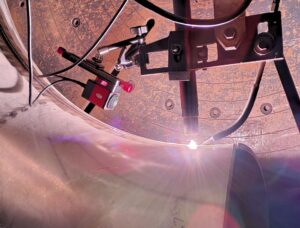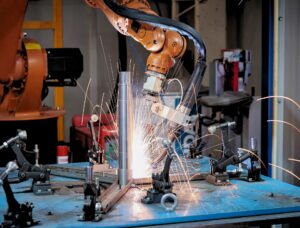The integration of robotic welding systems with advanced monitoring technology represents one of the most significant opportunities for manufacturers to maximize return on investment while achieving unprecedented quality and consistency. As robotic welding continues to expand across industries, automated weld monitoring has become essential for unlocking the full potential of these sophisticated systems. In this blog, we’ll explore how robotic welding integration with automated monitoring systems has become the cornerstone of modern manufacturing ROI strategies.
The Evolution of Robotic Welding
Robotic welding has evolved far beyond simple programmed movements. Modern systems incorporate:
Adaptive Control: Robots that adjust welding parameters in real-time based on joint variations and material properties.
Multi-Process Capability: Single systems capable of MIG, TIG, and even specialized processes like laser welding.
Collaborative Features: Robots designed to work safely alongside human operators in shared workspaces.
Intelligent Programming: Systems that learn optimal welding sequences and automatically optimize for quality and efficiency.
The Monitoring Integration Imperative
While robotic welding offers exceptional repeatability, it also creates unique monitoring challenges:
Consistency Verification: Robots repeat the same motions precisely, but material variations, fixturing inconsistencies, and consumable degradation can still cause quality issues.
Process Optimization: Without human observation, robotic systems need automated feedback to maintain optimal performance.
Quality Documentation: Automated systems must provide comprehensive documentation for quality assurance and traceability requirements.
Predictive Maintenance: Monitoring systems can detect when consumables need replacement or when calibration is required.
Key Technologies Enabling Integration
Machine Vision Systems: High-resolution welding camera that provide real-time feedback on weld quality and joint tracking.
Sensor Fusion: Integration of visual, thermal, acoustic, and electrical sensors for comprehensive process monitoring.
Edge Computing: Local processing power that enables real-time decision-making without latency issues.
Industrial Communication Protocols: Standardized interfaces that allow seamless integration with existing factory automation systems.
Real-Time Quality Control Capabilities
Advanced monitoring systems integrated with robotic welding provide several critical capabilities:
Adaptive Parameter Control: Automatic adjustment of welding parameters based on real-time quality feedback.
Joint Tracking: Dynamic path correction based on actual part positioning and joint geometry.
Defect Prevention: Early detection of conditions that lead to defects, with automatic corrective actions.
Quality Prediction: AI algorithms that predict final weld quality based on real-time process data.
ROI Calculation Framework
To maximize ROI from integrated robotic welding monitoring, manufacturers should evaluate:
Direct Cost Savings:
- Reduced scrap and rework
- Decreased inspection labor
- Lower consumable waste
- Reduced warranty claims
Productivity Improvements:
- Higher first-pass quality rates
- Reduced cycle times through optimization
- Increased equipment uptime
- Faster changeover times
Quality Benefits:
- Enhanced customer satisfaction
- Consistent weld quality
- Complete process documentation
- Reduced variation in final products
Implementation Strategies by Industry
Automotive Manufacturing: Focus on high-volume consistency and cycle time optimization. Implement monitoring systems that can handle rapid part changeovers and provide statistical process control data.
Heavy Equipment: Emphasize penetration monitoring and structural integrity verification. Systems must handle thick sections and high-deposition welding processes.
Electronics Manufacturing: Prioritize precision and minimal heat input. Monitoring systems need to detect subtle variations in micro-welding applications.
Shipbuilding: Balance between quality and productivity in long, continuous welds. Systems must integrate with existing hull construction workflows.
Integration Architecture Best Practices
Successful integration requires careful attention to system architecture:
Scalable Design: Systems that can grow with production needs and incorporate new monitoring technologies.
Open Standards: Use of industry-standard communication protocols for maximum flexibility and vendor independence.
Cybersecurity: Robust security measures to protect manufacturing data and prevent unauthorized access.
Redundancy: Backup systems and fail-safe mechanisms to ensure continuous operation.
Case Studies in ROI Maximization
Automotive Tier 1 Supplier: Implemented integrated monitoring across 24 robotic welding cells. Results included:
- 45% reduction in quality-related labor costs
- 30% improvement in first-pass quality
- 18-month payback period
- 200% ROI over five years
Heavy Equipment Manufacturer: Integrated monitoring with robotic welding of structural components:
- 14-month payback period
- 35% reduction in rework costs
- 25% improvement in weld penetration consistency
- 50% reduction in inspection time
Future Developments
The future of robotic welding monitoring integration includes several exciting developments:
Digital Twin Integration: Real-time monitoring data will feed into digital twin models that predict component performance and optimize welding parameters.
5G Connectivity: Ultra-low latency communications will enable cloud-based processing and remote monitoring capabilities.
Augmented Reality: AR interfaces will provide intuitive visualization of real-time quality data for operators and engineers.
Blockchain Documentation: Immutable quality records will enhance traceability and enable new business models based on quality verification.
Overcoming Implementation Challenges
Common challenges and solutions include:
Technical Integration: Work with experienced system integrators who understand both robotic welding and monitoring technologies.
Operator Training: Invest in comprehensive training programs that help operators understand and optimize the integrated system.
Change Management: Implement structured change management processes to ensure smooth adoption of new technologies.
Performance Measurement: Establish clear metrics and regular review processes to track ROI and identify optimization opportunities.
Maximizing Long-Term Value
To achieve maximum ROI from integrated robotic welding monitoring:
- Start with pilot programs to prove value before full-scale deployment
- Invest in operator training to ensure systems are used effectively
- Establish regular review processes to identify optimization opportunities
- Plan for scalability to accommodate future growth and technology advances
- Maintain vendor relationships for ongoing support and technology updates
Conclusion
The integration of advanced monitoring with robotic welding systems represents a significant opportunity for manufacturers to achieve unprecedented levels of quality, consistency, and efficiency. While the initial investment may be substantial, the potential returns—through reduced costs, improved quality, and enhanced competitiveness—make this technology essential for forward-thinking manufacturers.
Success requires careful planning, proper implementation, and ongoing optimization, but the companies that master this integration will have significant competitive advantages in an increasingly automated manufacturing landscape.
Ready to upgrade your welding quality control? Contact Mecaweld today to learn how our weld monitoring cameras and inspection systems help you catch problems before the arc strikes.



